Meaning of Burnt Offerings in the Bible: Total Devotion
Burnt offerings in the Bible, known as ‘olah’ in Hebrew, are a central aspect of ancient Israelite worship, serving as symbols of complete devotion, atonement, and spiritual purification. Outlined in Leviticus 1 and exemplified by patriarchal figures like Noah and Abraham (Genesis 8:20-21), these offerings involved the total consumption of the sacrificial animal by fire, signifying the worshiper’s total surrender to God.
Priests played vital roles in ensuring the sanctity and correct performance of these rituals, which were integral to maintaining communal and personal holiness. To explore the multifaceted significance and theological implications of these offerings, there is much more to uncover.

Meaning of Burnt Offerings in the Bible: Purpose, Symbolism, and Spiritual Lessons
| Aspect | Details |
|---|---|
| Term | Burnt Offerings |
| Biblical Meaning | A sacrifice completely consumed by fire, offered to God |
| Hebrew Term | Olah (עֹלָה) – meaning “to ascend” or “go up in smoke” |
| Purpose | Atonement for sin, expression of devotion, worship, and surrender |
| Key Scripture | Leviticus 1:3-9, Genesis 8:20, Exodus 29:18 |
| Spiritual Symbolism | Total dedication to God, purification, and acceptance through sacrifice |
| Faith Insight | Foreshadows the ultimate sacrifice of Jesus, fulfilling the law through grace |
Historical Context
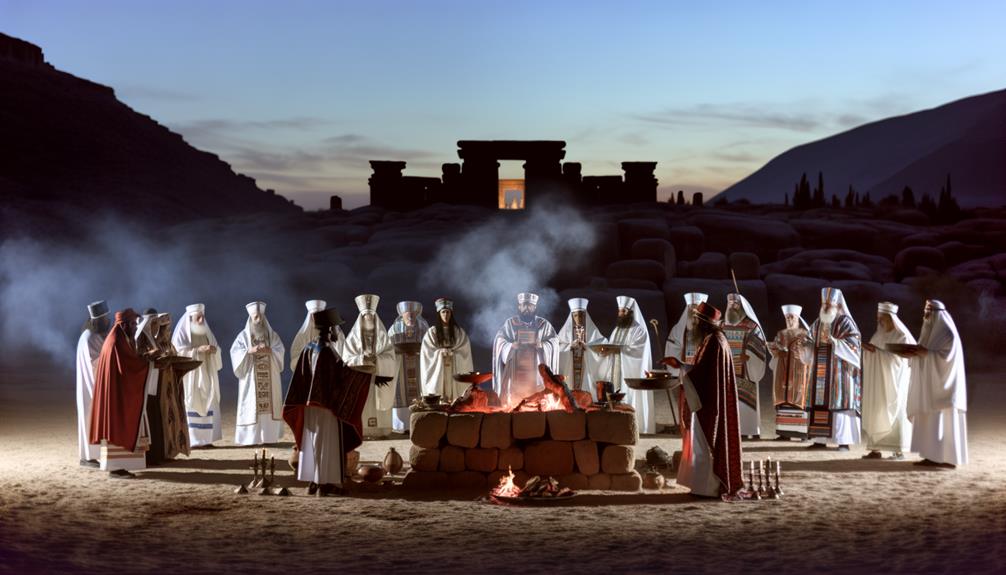
In ancient Israelite religion, burnt offerings, also known as ‘olah’ in Hebrew, were a central element of worship, symbolizing atonement and complete devotion to God. These offerings are extensively detailed in the Torah, particularly in Leviticus 1:1-17.
Historical records indicate that the practice dates back to the patriarchal period, as seen with Noah (Genesis 8:20) and Abraham (Genesis 22:2-13).
Burnt offerings were conducted on altars, often constructed of uncut stones (Exodus 20:25), signifying purity and divine ordinance. Archaeological evidence from sites like Tel Arad and Beersheba further elucidates the prevalence of these rituals.
The practice of burnt offerings was integral to Israelite temple worship, highlighting their theological significance and cultural pervasiveness in ancient Near Eastern societies.
Definition and Purpose
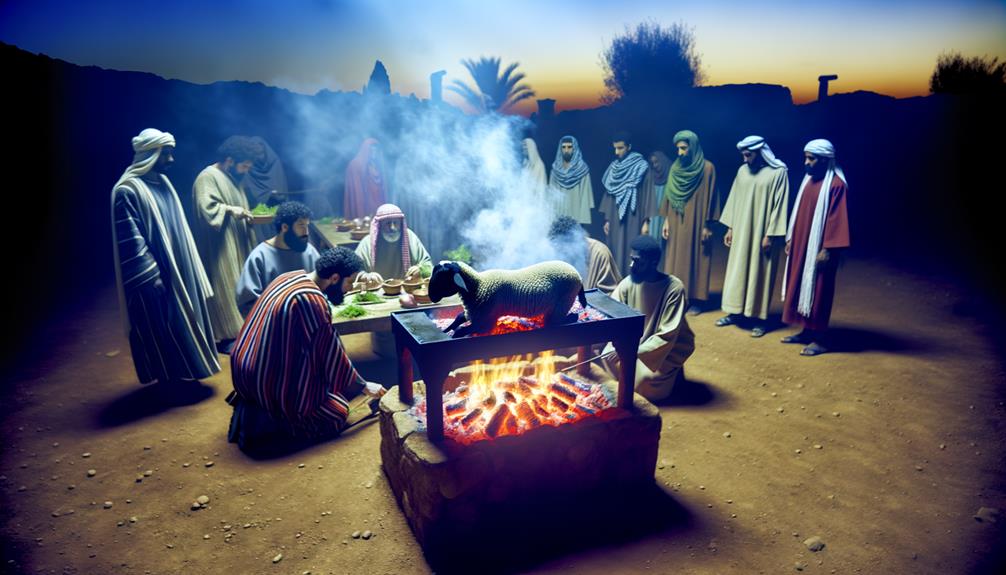
Burnt offerings in the Bible, often referred to as ‘olah’ in Hebrew, were sacrifices entirely consumed by fire, symbolizing complete devotion to God (Leviticus 1:9).
These rituals held profound significance in ancient worship practices, serving as expressions of atonement and acts of worship.
Symbolism in Sacrifices
The symbolism in sacrifices, particularly burnt offerings, is deeply rooted in the theological understanding of atonement and devotion, as illustrated throughout various scriptural passages and historical contexts.
In Leviticus 1, the burnt offering represents complete surrender to God, signifying the offerer’s desire for reconciliation and purification. This act of burning the entire sacrifice symbolizes the totality of the individual’s commitment and the transformation through divine grace.
Historically, such offerings underscored a communal acknowledgment of sin and need for divine mercy, fostering a shared spiritual discipline.
Additionally, Genesis 8:20-21 describes Noah’s burnt offering post-flood, which elicited God’s promise never to curse the ground again, highlighting the profound covenantal aspect embedded in these sacrificial rites.
Ritualistic Significance Explained
Exploring the ritualistic significance of burnt offerings, it becomes evident that these sacrifices served not only as acts of devotion but also as mechanisms for spiritual purification and covenantal reaffirmation.
Scriptural references, such as Leviticus 1:3-17, underscore the importance of these offerings in maintaining a sacred relationship with God. Historically, burnt offerings were integral to Israelite worship, symbolizing total surrender to the Divine.
These offerings had profound emotional and theological implications:
- Atonement for Sin: Leviticus 1:4 emphasizes that burnt offerings were a means to obtain divine forgiveness.
- Expression of Devotion: They demonstrated the worshiper’s complete dedication (Leviticus 1:9).
- Covenantal Reaffirmation: Renewing one’s commitment to God’s covenant (Genesis 8:20-21).
Understanding these elements fosters deeper insights into ancient faith practices.
Ancient Worship Practices
Ancient worship practices in the biblical context were deeply rooted in rituals that aimed to foster a direct and intimate relationship with the Divine, as evidenced by numerous scriptural mandates and historical traditions.
Central to these rituals were burnt offerings, which served as a tangible expression of devotion and repentance. Leviticus 1:3-4 details the requirements for burnt offerings, illustrating their role in atonement and consecration.
Historical records show that these practices were not only acts of obedience but also communal engagements, uniting the worshippers in shared reverence.
Through these rituals, the Israelites sought to maintain purity and favor with God, ensuring the continual presence of the Divine among them (Exodus 29:42-46).
Types of Burnt Offerings
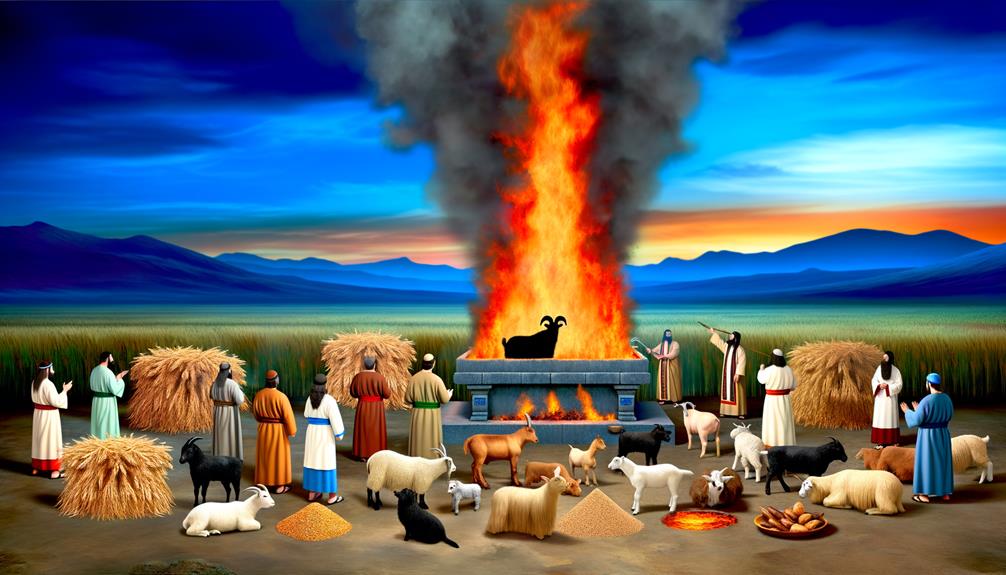
Multiple types of burnt offerings are delineated in the Old Scriptures, each serving distinct theological and ritualistic purposes within the covenantal framework.
These offerings are meticulously prescribed in the Torah, reflecting Israel’s relationship with the Divine.
Key types include:
- Olah (Leviticus 1:3-17): A voluntary offering, symbolizing complete submission to God’s will. It was wholly consumed by fire, signifying total dedication.
- Tamid (Exodus 29:38-42): A daily burnt offering, maintaining continual atonement and reminding Israel of God’s perpetual presence.
- Special Occasions (Numbers 28:11-15): Offered during significant feasts and festivals, enhancing communal worship and covenantal remembrance.
These varied sacrifices illustrate profound spiritual truths, anchoring Israel’s worship in a rich tapestry of ritualistic expression.
Ritual Procedures
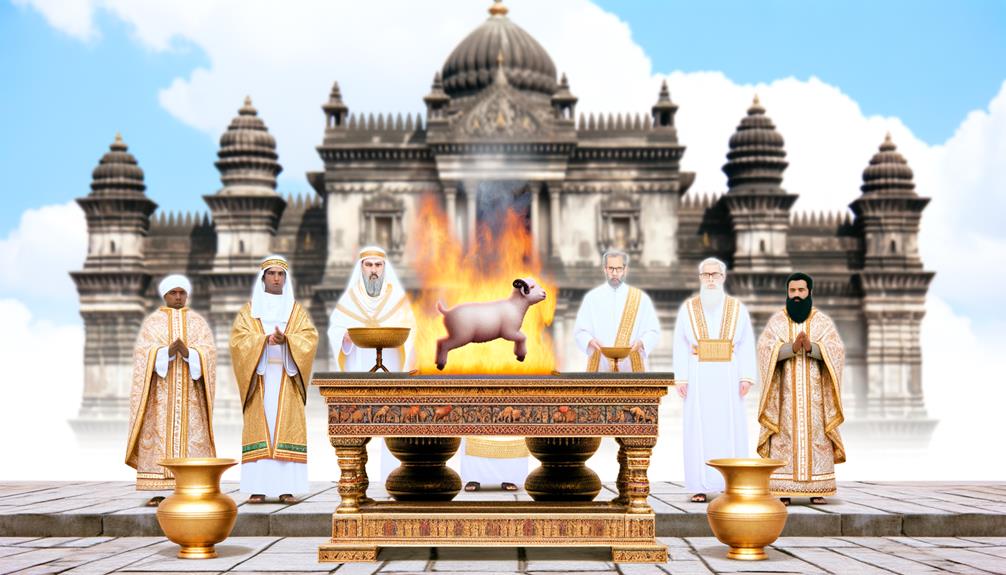
The ritual procedures for burnt offerings, as detailed in Leviticus and other biblical texts, encompass a series of meticulously prescribed actions designed to guarantee both the sanctity and the efficacy of the sacrifices.
Leviticus 1:3-9 outlines the initial steps: the selection of an unblemished male animal, the offerer laying hands on its head to symbolize substitution, and the priest’s role in slaughtering the animal.
The blood was then sprinkled around the altar, signifying atonement (Leviticus 17:11). The animal’s carcass was meticulously skinned, cut into pieces, and arranged on the altar to be completely consumed by fire, signifying total surrender to God (Leviticus 1:9).
This procedure facilitated a sacred interaction between humanity and the Divine, ensuring ritual purity and divine acceptance.
Symbolism and Significance
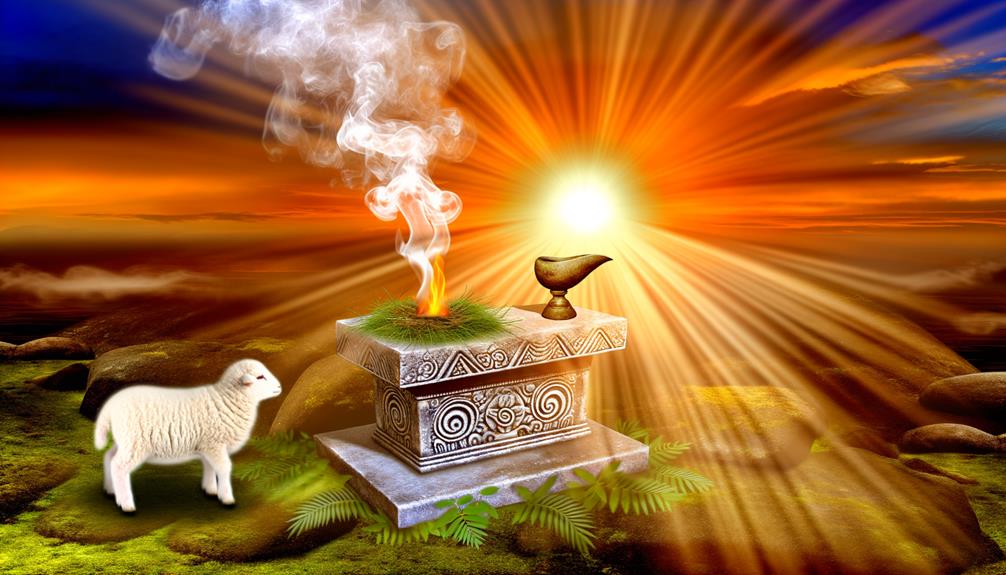
Understanding the ritual procedures is fundamental to grasping the deep symbolism and spiritual significance that burnt offerings held within the biblical tradition. These offerings, described in Leviticus 1, served as a profound expression of devotion and atonement.
The symbolic elements of burnt offerings include:
- Total Surrender: The complete consumption by fire symbolizes the worshipper’s total dedication to God (Leviticus 1:9).
- Purification: The offering’s burning represents the purification from sin, underscoring the need for holiness (Leviticus 1:4).
- Divine Acceptance: The pleasing aroma to the Lord signifies divine acceptance and favor (Leviticus 1:13).
These elements reveal the intricate relationship between human repentance, divine holiness, and the covenantal bond in ancient Israelite worship practices.
Theological Implications

The theological implications of burnt offerings in the Bible are profound, encompassing the symbolism of sacrifice, the covenant relationship between God and humanity, and the process of spiritual purification.
Scriptural references such as Leviticus 1:3-4 elucidate the role of burnt offerings in achieving atonement and reinforcing divine covenants.
Historically, these rituals served as tangible expressions of faith and commitment, illustrating the transformative power of repentance and consecration.
Symbolism of Sacrifice
In the biblical context, sacrifices, particularly burnt offerings, symbolize a profound act of devotion and atonement, reflecting humanity’s quest for reconciliation with the divine.
These offerings, detailed in Leviticus 1, serve as a tangible expression of faith and repentance, invoking a deep spiritual connection with God. The theological implications underscore the gravity of sin and the necessity of seeking divine forgiveness.
The symbolism of sacrifice in burnt offerings can evoke powerful emotions:
- Humility and surrender: Acknowledging human limitations before a sovereign God.
- Purification: The burning process symbolizes purification, as seen in Malachi 3:3.
- Commitment: Demonstrating unwavering commitment to God’s will.
These elements highlight the intricate relationship between worship, obedience, and divine favor.
Covenant and Atonement
Examining the theological implications of burnt offerings reveals their foundational role in establishing the covenant relationship between God and His people, serving as a means for atonement and a precursor to the ultimate sacrifice in Christ.
In Leviticus 1, God commands burnt offerings to symbolize dedication and repentance. These sacrifices were integral for maintaining Israel’s covenant, as seen in Genesis 15:9-18 and Exodus 24:5-8.
The offerings facilitated atonement, reconciling humanity with divine holiness (Leviticus 16:24). This sacrificial system prefigured Christ’s atonement (Hebrews 10:1-10), bridging the Old and New Covenants.
Understanding these practices in historical and scriptural contexts underscores their significance in God’s redemptive plan, culminating in the ultimate sacrifice on the cross.
Spiritual Purification Process
Burnt offerings in the biblical context served as a profound spiritual purification process, symbolizing the worshiper’s repentance and complete devotion to God. Theologically, these sacrifices underscored the seriousness of sin and the necessity of atonement.
Scriptural references such as Leviticus 1:4-9 illustrate the ritual’s meticulousness, reflecting the purity required for reconciliation with God. Historically, burnt offerings were integral to Israelite worship, embodying profound spiritual truths.
The spiritual purification process through burnt offerings can be understood through:
- Total Consecration: The offering was entirely consumed by fire, representing the giver’s total surrender to God.
- Substitutionary Atonement: The animal symbolized the worshiper’s sins being transferred and purged.
- Divine Acceptance: The sweet aroma signified God’s acceptance and forgiveness (Leviticus 1:9).
Understanding these elements deepens appreciation for the sacrificial system’s theological richness.
Key Biblical Passages
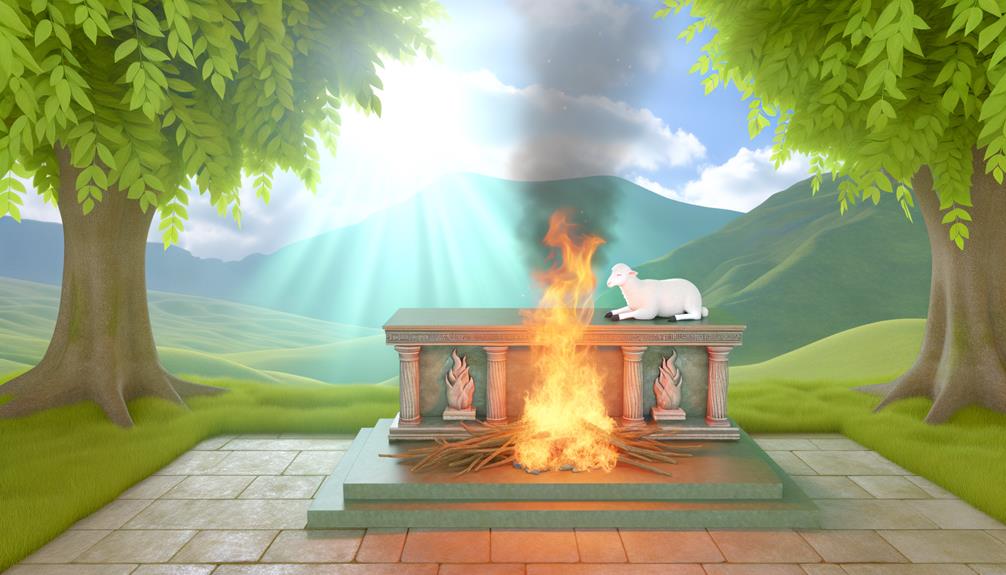
Several significant biblical passages provide profound insights into the role and meaning of burnt offerings within the scriptural and historical context of ancient Israel.
Leviticus 1:3-17 meticulously details the procedures for burnt offerings, highlighting their purpose in atonement and dedication to God.
Genesis 8:20-21 describes Noah’s burnt offering post-flood, symbolizing divine appeasement.
In Exodus 29:18, the aroma of burnt offerings is depicted as pleasing to the Lord, signifying acceptance and consecration.
The narrative in 1 Kings 18:38, where Elijah’s burnt offering is consumed by divine fire, underscores God’s power and approval.
These passages collectively portray burnt offerings as multifaceted acts of worship, embodying penitence, devotion, and divine communion within the Israelite sacrificial system.
Role of Priests
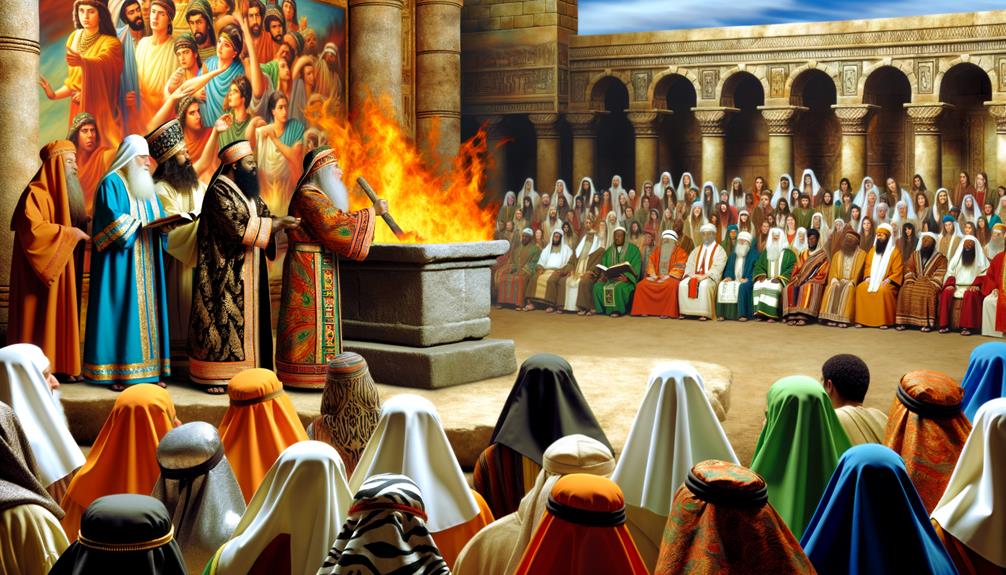
The priests in ancient Israel played an essential role in the administration of burnt offerings, acting as mediators between the people and God and ensuring the proper execution of sacrificial rites as outlined in the Torah. Their duties were manifold:
- Sanctity: Upholding the sanctity of the sacrificial process (Leviticus 21:6), ensuring offerings were unblemished and acceptable.
- Intercession: Serving as intercessors (Exodus 28:1) who represented the people’s atonement needs before God.
- Instruction: Educating the Israelites on the laws and significance of offerings (Leviticus 10:11), fostering spiritual understanding and obedience.
These roles underscored the priests’ crucial function in maintaining the covenantal relationship between God and His people, rooted in meticulous adherence to divine commandments.
Comparisons to Other Sacrifices

In the context of ancient Israelite worship, burnt offerings hold a distinct place among the various types of sacrifices, each serving unique theological and ritualistic purposes as delineated in the Torah.
Unlike sin offerings, which were intended for atonement of specific transgressions (Leviticus 4:1-35), burnt offerings (Leviticus 1:1-17) symbolized total surrender to God, as the entire animal was consumed by fire.
Peace offerings (Leviticus 3:1-17), in contrast, were communal meals celebrating reconciliation and fellowship with God. Grain offerings (Leviticus 2:1-16) signified thanksgiving and dedication.
Each type of sacrifice consequently contributed to the holistic spiritual life of the Israelites, reflecting their multifaceted relationship with the Divine, encompassing repentance, devotion, and communion.
Modern Interpretations

Modern interpretations of burnt offerings in the Bible often reflect contemporary religious views that emphasize the symbolism of complete dedication to God, as seen in Romans 12:1, which encourages believers to offer their bodies as living sacrifices.
This ancient practice is recontextualized in today’s worship as a metaphor for spiritual commitment and purity.
Comparative theological analysis highlights the continuity and divergence of sacrificial themes across different faith traditions, offering a rich tapestry of understanding regarding the enduring significance of these rites.
Contemporary Religious Views
Contemporary religious scholars interpret burnt offerings in the Bible as symbolic acts of devotion, purification, and atonement, reflecting a deeper spiritual significance that transcends the literal act of sacrifice. These interpretations are rooted in theological knowledge, scriptural references, and historical context, providing a profound understanding of their enduring relevance.
- Devotion: Burnt offerings represented total commitment to God, as seen in Genesis 22:2 when Abraham was asked to sacrifice Isaac.
- Purification: Leviticus 1:3-4 details how offerings were made to purify individuals, symbolizing cleansing from sin.
- Atonement: The sacrificial system in Leviticus 16 illustrated atonement for the community’s sins, pointing forward to ultimate reconciliation.
These elements underscore the multifaceted nature of burnt offerings, inviting deeper reflection on their spiritual import.
Symbolism in Worship Today
Many theologians today draw upon the rich symbolism of burnt offerings to enhance contemporary worship practices, emphasizing themes of sacrifice, devotion, and spiritual renewal.
Rooted in Levitical traditions (Leviticus 1:3-17), burnt offerings were a means of seeking atonement and communion with God.
Modern interpretations often relate these ancient rituals to the New Covenant‘s spiritual sacrifices (Romans 12:1), inviting believers to present their lives as living sacrifices. This symbolic act reflects a heart fully committed to God, mirroring Christ’s ultimate sacrifice.
Additionally, historical contexts highlight the transformative power of such offerings, encouraging today’s worshippers to embrace deeper spiritual disciplines and communal expressions of faith, thereby fostering a sense of unity and purpose within the body of Christ.
Comparative Theological Analysis
A comparative theological analysis of modern interpretations reveals that the concept of burnt offerings continues to resonate profoundly within contemporary Christian thought, drawing parallels between ancient rituals and present-day spiritual practices.
Today’s believers often view these offerings as symbolic acts of surrender and devotion, echoing biblical sacrifices (Leviticus 1:4).
- Sacrifice of Praise: Hebrews 13:15 encourages believers to offer a ‘sacrifice of praise,’ symbolizing a heartfelt devotion comparable to burnt offerings.
- Living Sacrifices: Romans 12:1 calls Christians to present their bodies as ‘living sacrifices,’ reflecting total commitment akin to ancient rites.
- Atonement and Forgiveness: The ultimate sacrifice of Jesus (Hebrews 10:10) is seen as the fulfillment of all burnt offerings, encapsulating the themes of atonement and divine forgiveness.
These comparisons underscore the enduring spiritual significance of sacrificial acts.
Conclusion
Burnt offerings, deeply rooted in biblical tradition, serve as profound symbols of atonement, devotion, and covenantal relationship with the Divine.
The intricate procedures and distinct types underscore the gravity and reverence demanded by such sacred acts.
Scriptural accounts, from Genesis to Leviticus, elucidate their enduring theological significance.
Reflecting on these ancient rites invites contemplation akin to the sacrificial lamb’s foreshadowing within the New Covenant, revealing a continuum of faith and divine reconciliation.






